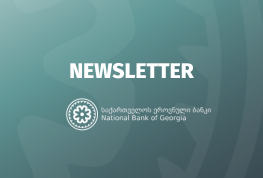Fitch Rtgs: Regulation and Rate Rises to Keep Lid on Georgian Bank Lending
Loan growth at Georgian banks should stay under control in the near term as stricter regulatory standards for retail lending and tightened monetary policy constrain new lending, Fitch Ratings said at its recent annual conference on Georgia.
Annualised credit growth slowed to 7.7% in 1H19 (net of exchange-rate effects) from 17.2% in 2018, following the introduction of more stringent affordability criteria early this year to tackle excessive retail lending growth. We expect that recent increases to the policy rate in response to exchange-rate volatility and ensuing inflationary pressure will help to dampen loan growth by pushing up the cost of local-currency borrowing. Foreign-currency (FC) loan growth is likely to be tempered by an increase in the minimum FC retail loan amount early this year to help address high loan dollarisation.
De-dollarisation is proving to be a slow process, meaning that banks' credit and solvency metrics are still sensitive to exchange-rate movements. Loan dollarisation was 57% at end-1H19 and deposit dollarisation was 63%, both high and barely changed since end-2017 (57% and 66%, respectively). The Georgian lari has depreciated by about 11% against the US dollar since the start of 2019, and while the banking sector's regulatory non-performing loans remain stable (end-1H19: 5.7% of gross loans), further depreciation could weaken asset quality as borrowers are largely unhedged.
To limit dollarisation risk from short-term FC liabilities, Georgian banks are required to place FC reserves equivalent to 30% of their short-term FC liabilities at the central bank. However, long-term FC liabilities, which have lower reserve requirements (and sometimes none), represent a growing dollarisation risk. Banks are increasingly dependent on long-term external funding sources to finance their growth due to limited availability of local-currency funding, notably customer deposits, and external borrowings now represent a third of sector liabilities, having grown to USD4.4 billion at end-1H19 from USD3.0 billion at end-2016. However, the associated refinancing risk appears limited in the near term given the long-term nature of most of the external borrowings and the external liquidity that banks hold to cover upcoming maturities.
"We maintain our stable outlook for the Georgian banking sector as good near-term economic prospects should help to support banks' financial profiles. Most banks have solid capital buffers and healthy profitability that should make them resilient to moderate levels of stress. The sector's regulatory Tier 1 and total capital adequacy ratios were 14.5% and 19.0%, respectively, at end-1H19, and the annualised return on average equity was 14%".
We rate seven banks in Georgia: TBC Bank (BB-/Stable), Bank of Georgia (BB-/Stable), Liberty Bank (B+/Stable), ProCredit Bank (Georgia) (BB+/Stable), Basisbank (B+/Stable), Cartu Bank (B/Stable) and Halyk Bank Georgia (BB-/Positive). The banks' ratings are sensitive to the performance of the domestic economy and the stability of the local currency. Improvements in the operating environment, driven, for example, by further diversification and growth of Georgia's economy, would increase the potential for upgrades, as would a notable decrease in loan dollarisation. A material increase in banks' risk appetite or a deterioration in their asset quality that leads to significant capital erosion could put ratings under pressure.

